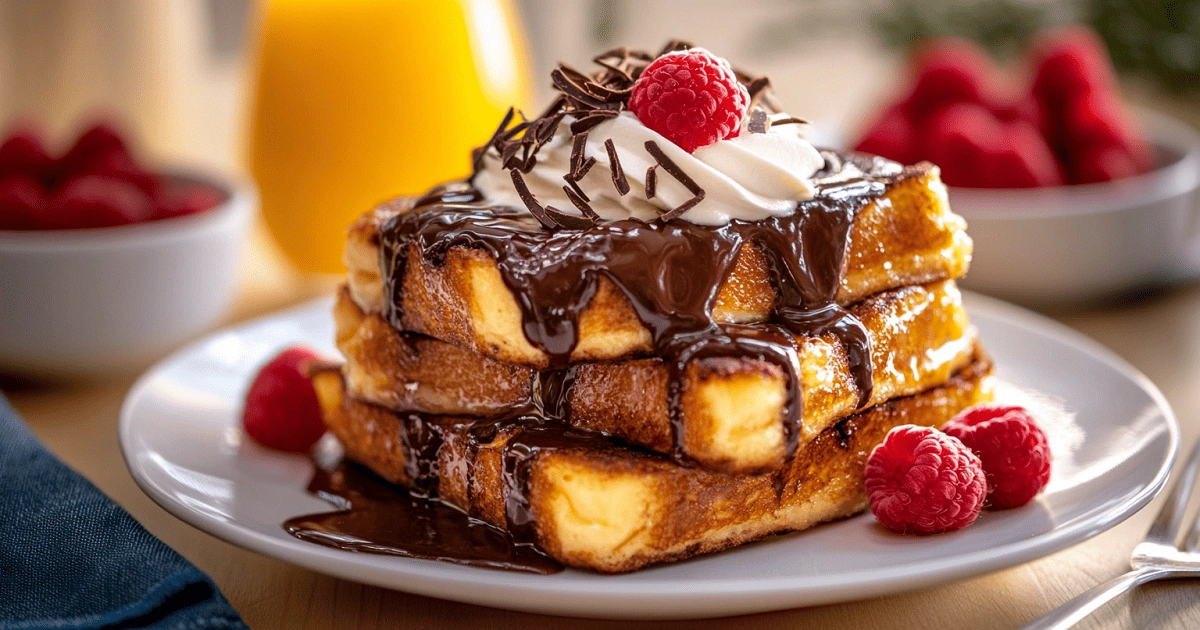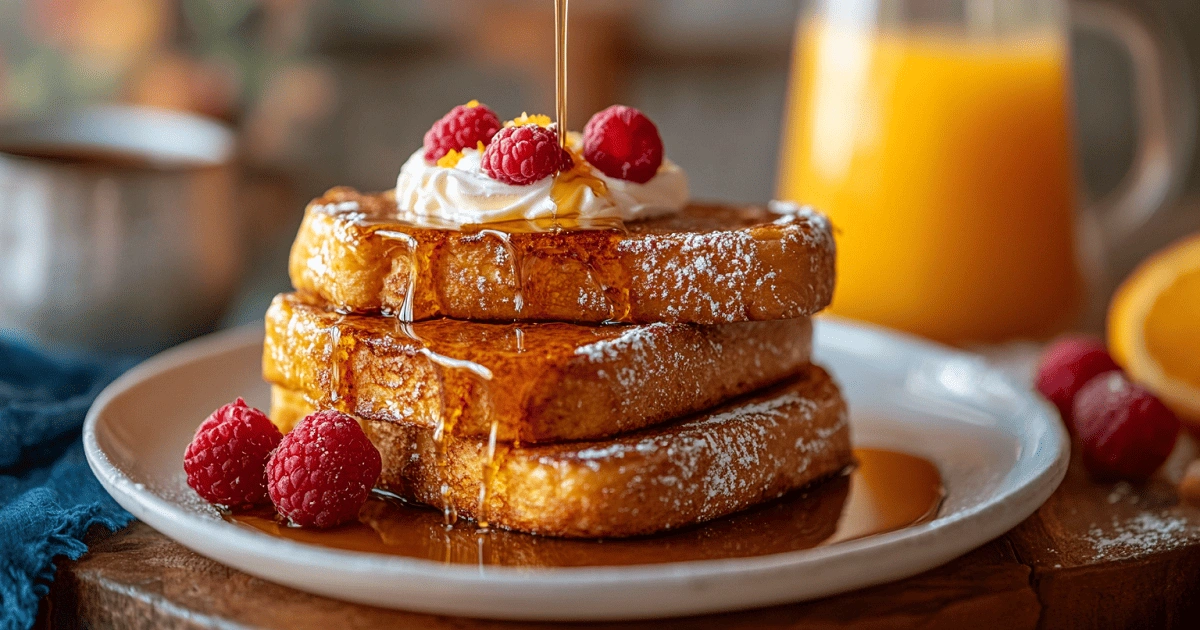Belgian French toast has gained widespread popularity for its rich flavors and distinct preparation. Unlike traditional French toast, which many people associate with American or French cuisine, the Belgian version stands out due to its use of brioche bread and luxurious ingredients. Although it shares roots with the classic dish, Belgian French toast offers a unique twist, making it a must-try for breakfast lovers worldwide.
This article dives into the history, preparation, and serving styles of Belgian French toast. Additionally, we’ll explore how it compares to other versions of French toast and provide a detailed guide for making this indulgent breakfast at home. For those interested in enhancing their breakfast game, Belgian French toast is a perfect choice. Curious to learn more about other French toast variations? Visit this perfect fluffy French toast guide.
What Is Belgian French Toast?
Belgian French toast is a variation of the classic French toast, often referred to as Pain perdu. This version uses brioche bread, a rich and buttery loaf, which soaks up the egg mixture beautifully. The finished dish boasts a soft and creamy interior with a crispy, golden-brown crust. The use of brioche elevates the dish from a simple breakfast to a more indulgent, luxurious experience.
Unlike other versions of French toast that rely on everyday bread, Belgian French toast showcases the country’s love for high-quality ingredients. The thicker slices of brioche make it ideal for absorbing more of the custard mixture, giving each bite a rich, decadent flavor. Toppings like powdered sugar, syrup, fresh fruit, and whipped cream are common, but the Belgian version also allows for more creative toppings such as chocolate drizzle or nuts.
How It Differs From Regular French Toast
There are several key differences between Belgian French toast and regular French toast. Firstly, the choice of bread is crucial. While typical French toast uses regular sliced bread or stale baguettes, Belgian French toast opts for brioche. The sweetness and richness of brioche create a softer, fluffier toast, resulting in a dish that is both light and indulgent. Another significant difference is the use of toppings. While syrup and powdered sugar are common across many variations, the Belgian version often includes fresh berries, whipped cream, or chocolate sauce, making the dish feel like a luxurious treat.
Moreover, Belgian French toast offers a more balanced flavor profile. The egg mixture used to soak the bread usually contains hints of vanilla or cinnamon, which enhance the richness of the bread without overpowering its flavor. The emphasis on quality ingredients and presentation gives the Belgian version its unique identity.
Print
How to Make Belgian French Toast: A Luxurious Breakfast Treat
- Total Time: 20 minutes
- Yield: 2 servings (2 slices per person)
- Diet: Vegetarian
Description
Crispy on the outside, soft and custardy on the inside—this French toast is made with thick slices of brioche and a rich vanilla custard soak. Fry it up golden and top with your favorites like maple syrup, whipped cream, or fresh berries. Whether it’s a Sunday brunch or just a cozy morning, this toast is luxury on a plate! 💛
Ingredients
- 4 thick slices of brioche bread (day-old is best)
• 2 large eggs
• ½ cup milk (or almond milk)
• 1 tbsp sugar (optional)
• ½ tsp vanilla extract
• Butter for frying
Toppings (Optional):
• Powdered sugar
• Maple syrup
• Fresh berries
• Whipped cream
• Chocolate sauce or caramel drizzle
Instructions
1️⃣ Make the Custard:
• In a shallow bowl, whisk together eggs, milk, sugar, and vanilla extract until smooth and slightly frothy.
2️⃣ Soak the Bread:
• Dip each brioche slice in the custard mixture, coating both sides.
• Let soak for about 30 seconds per side—enough to absorb without falling apart.
3️⃣ Fry the French Toast:
• Heat a skillet over medium heat and melt a generous amount of butter.
• Fry soaked brioche slices 2–3 minutes per side until golden brown and crisp.
4️⃣ Serve & Garnish:
• Plate and top with your favorite toppings.
• Serve warm for the best texture and flavor!
Notes
-
Use day-old brioche: It soaks up custard without falling apart.
-
Soak smart: 30 seconds per side is enough—don’t oversaturate.
-
Fry with patience: Medium heat ensures a golden exterior without burning.
-
Customize toppings: Add powdered sugar, syrup, whipped cream, or fruit.
-
Serve fresh: Best enjoyed hot right from the pan for crisp edges and a custardy center.
- Prep Time: 10 minutes
- Cook Time: 10 minutes
- Category: Breakfast / Brunch
- Method: Pan-Fried
- Cuisine: Belgian-Inspired
The Importance of Brioche Bread in Belgian French Toast
The type of bread plays a crucial role in creating the perfect Belgian French toast. Brioche bread, known for its rich texture and buttery taste, is the key element that sets this version apart from others. The bread’s natural sweetness complements the savory egg mixture, creating a balanced flavor that is both light and satisfying.
Brioche also has a unique ability to hold up well when soaked in the egg custard mixture, allowing it to absorb the flavors without becoming too soggy. The outcome is an impeccably crisp exterior with a soft, custard-like interior that dissolves delightfully in your mouth. This contrast in texture makes Belgian French toast particularly appealing.
In addition to its texture and flavor, brioche bread adds a level of sophistication to the dish. Its golden, fluffy appearance makes the presentation of the toast even more appetizing, and the richness of the bread enhances the dish’s overall indulgence.
Historical Perspective
Though French toast has ancient origins, dating back to Roman times, the Belgian take on this classic dish has evolved significantly over the years. In the past, French toast was considered a practical way to use up stale bread, which was soaked in milk and eggs before being fried. However, in Belgium, this dish became a symbol of indulgence, largely due to the use of high-quality ingredients like brioche bread.
How Belgian French Toast Became Popular
Belgium has a strong culinary tradition of creating rich, flavorful foods, and Belgian French toast is no exception. Over time, what began as a simple, resourceful dish transformed into a luxurious breakfast option. In Belgian culture, breakfast is not merely a quick meal; it is an opportunity to enjoy good food with family and friends. This emphasis on quality and indulgence has helped Belgian French toast gain a reputation as a staple breakfast dish in both homes and cafes.
Today, Belgian French toast is often featured on brunch menus across the country and beyond. Its versatility allows for endless creativity, with restaurants offering various toppings and fillings to suit different tastes. Whether served with fresh fruit and syrup or with a more savory touch like nuts and honey, this dish remains a crowd favorite.
How Belgian French Toast Is Served
One of the most appealing aspects of Belgian French toast is its versatility. It can be served in a variety of ways, with a wide range of toppings that cater to both sweet and savory preferences.
Popular Sweet Toppings:
- Powdered sugar: A classic option, adding a light sweetness to the crispy exterior.
- Fresh berries: Strawberries, blueberries, and raspberries add a fresh, tangy contrast to the rich flavors of the toast.
- Whipped cream: with its light and airy texture, complements the tender softness of brioche beautifully.
- Maple syrup or honey: These sweeteners enhance the natural richness of the brioche, without overwhelming the dish.
- Chocolate sauce: For those with a sweet tooth, a drizzle of melted chocolate elevates the dish to dessert-level indulgence.

Savory Options:
Though less common, Belgian French toast can also be served with savory toppings. Some variations include:
- Cheese: A mild cheese like ricotta or cream cheese can be spread on the toast to add creaminess.
- Nuts: Almonds, walnuts, or pecans can be sprinkled on top for extra texture and flavor.
- Herbs: A hint of fresh mint or basil can offer a refreshing contrast to the sweetness of the toast.
For more creative ways to serve French toast, check out this stuffed French toast recipe.
Belgian French Toast vs. Belgian Waffles
Belgium is equally famous for both its waffles and French toast, so how do they compare?
The Textural Difference
One of the most noticeable differences between these two beloved breakfast items is their texture. Belgian waffles are famous for their crispy exterior and soft, fluffy interior, which makes them a lighter breakfast option. In contrast, Belgian French toast offers a more custard-like texture inside, achieved through the soaking process. The crispy exterior of the toast comes from frying it in butter, adding an indulgent richness to each bite.
Toppings
Both dishes can be served with similar toppings like fresh fruits, syrup, or whipped cream. However, Belgian French toast offers a more indulgent experience due to the richness of the brioche. It’s more filling and tends to be the dish of choice for those looking to treat themselves.
For more information on Belgian breakfast dishes, check out this guide to Belgian breakfast traditions.
How to Make Belgian French Toast at Home
Making Belgian French toast at home is not only a simple process but also a delightful way to bring a touch of luxury to your breakfast table. The use of brioche bread adds richness and depth to the dish, turning a standard breakfast into a special occasion. This easy-to-follow recipe will guide you through creating perfectly crisp and golden French toast that’s soft and custardy on the inside.
Ingredients:
- 4 thick slices of brioche bread (day-old bread works best)
- 2 large eggs
- 1/2 cup milk (or a dairy-free alternative such as almond milk)
- 1 tablespoon sugar (optional for added sweetness)
- 1/2 teaspoon vanilla extract
- Butter for frying
- Choose your favorite toppings: powdered sugar, fresh berries, maple syrup, or chocolate sauce.

Instructions:
- Prepare the custard mixture: In a shallow bowl, whisk together the eggs, milk, sugar, and vanilla extract until well combined. The custard should be smooth and slightly frothy.
- Soak the bread: Take each slice of brioche bread and dip it into the egg mixture, ensuring that both sides are thoroughly coated. Allow each slice to soak for approximately 30 seconds per side, giving the bread enough time to absorb the flavors without becoming too soggy.
- Fry the bread: Heat a non-stick skillet over medium heat and melt a generous pat of butter. Once the butter is sizzling, add the soaked slices of brioche. Fry each slice for 2-3 minutes on each side, until they are golden brown and crispy on the outside while still soft inside.
- Serve and garnish: Once fried, plate the French toast and garnish with your favorite toppings. Whether you prefer a simple dusting of powdered sugar, a drizzle of maple syrup, or a handful of fresh berries, the options are endless. You can even add a dollop of whipped cream or a sprinkle of nuts for added texture.
Tips for the Perfect Belgian French Toast:
- Use day-old brioche: Slightly stale brioche is ideal for French toast because it holds its shape better after soaking in the custard mixture. Fresh bread may become too soft and fall apart when cooking.
- Don’t soak too long: Avoid soaking the bread in the egg mixture for too long, as it can become overly saturated. Around 30 seconds on each side is just enough to absorb the flavor while maintaining the bread’s structure.
- Medium heat is key: Frying the bread over medium heat ensures that it cooks evenly, giving the toast a golden, crispy exterior without burning. If the heat is too high, the outside may cook too quickly while leaving the inside undercooked.
- Customize with toppings: The versatility of Belgian French toast allows you to experiment with various toppings. For a classic breakfast, stick to powdered sugar and syrup. If you’re looking for something more indulgent, try adding whipped cream, chocolate sauce, or caramelized bananas.

Making Belgian French toast at home provides a rewarding experience. Creating such a luxurious breakfast is not just delicious, but also immensely gratifying. Whether you’re making it for yourself or to impress guests, this dish is sure to be a hit. For further variations and inspiration, explore our perfect fluffy French toast guide.
FAQs
1. What is French toast called in Belgium?
In Belgium, the term for French toast is “Pain perdu,” which means “lost bread.” This designation comes from the custom of utilizing stale or “lost” bread to prepare the dish.
2. What is the difference between French toast and Bombay toast?
Bombay toast offers a savory twist on traditional French toast, often seasoned with spices such as pepper, while Belgian French toast leans towards the sweeter side, commonly adorned with syrup, powdered sugar, and a variety of fresh fruits.
3. What is British French toast?
In Britain, French toast is commonly called Eggy bread. Unlike Belgian French toast, which is sweet and made with brioche, Eggy bread is usually savory, served with toppings like cheese or tomatoes.
4. What country invented French toast?
French toast is believed to have originated in ancient Rome, where stale bread was soaked in milk and eggs before being fried. The dish spread across Europe, and each country developed its own version over time.
Conclusion:
Belgian French toast is a decadent treat that every breakfast lover should experience at least once. What sets it apart from regular French toast is the use of brioche bread, which adds an unparalleled richness and buttery texture to the dish. The fluffy, slightly sweet nature of brioche absorbs the egg mixture perfectly, resulting in a melt-in-your-mouth sensation. The crisp exterior and soft, custard-like interior make each bite feel indulgent, yet comforting. Whether you opt for classic toppings like powdered sugar and syrup or go for something more elaborate like whipped cream, fresh berries, or even chocolate sauce, Belgian French toast is versatile and can be customized to suit any palate.
One of the best things about Belgian French toast is how easy it is to prepare at home. It’s an ideal way to elevate your usual breakfast routine, turning an ordinary morning into something special. Whether you’re hosting a brunch or treating yourself to a quiet morning meal, this dish is bound to impress. The richness of the brioche combined with your favorite toppings will make this breakfast one you’ll crave again and again. If you’re eager to try more variations, explore this perfect fluffy French toast guide for further inspiration.

